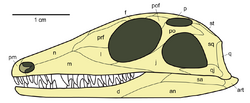Biology:Younginiformes
| Younginiformes | |
|---|---|

| |
| Skull of Youngina | |
| Scientific classification | |
| Domain: | Eukaryota |
| Kingdom: | Animalia |
| Phylum: | Chordata |
| Class: | Reptilia |
| Clade: | Neodiapsida |
| Order: | †Younginiformes Romer, 1945 |
| Families | |
| |
Younginiformes is a group of diapsid reptiles known from the Permian-Triassic of Africa and Madagascar. It has been used as a replacement for "Eosuchia".[1] Younginiformes (including Acerosodontosaurus, Hovasaurus, Kenyasaurus, Tangasaurus, Thadeosaurus and Youngina) were historically suggested to be lepidosauromorphs, but were later suggested to be basal non-saurian neodiapsids.[2][3] The group is sometimes divided into two families, Tangasauridae and Younginidae. The monophyly of the group is disputed. A 2009 study found them to be an unresolved polytomy at the base of Neodiapsida,[4] while a 2011 study recovered the group as paraphyletic.[5] A 2022 study recovered the Younginiformes as a monophyletic group of basal neodiapsid reptiles, also including Claudiosaurus and Saurosternon as part of the group.[6] Some younginiforms like Hovasaurus and Acerosodontosaurus are thought to have had an amphibious lifestyle, while others like Kenyasaurus, Thadeosaurus and Youngina were probably terrestrial.[4]
Classification
Included genera:
- Tangasauridae
- Acerosodontosaurus Currie, 1980
- Hovasaurus Piveteau, 1926
- Kenyasaurus Harris & Carroll, 1977
- Saurosternon? Huxley, 1868
- Tangasaurus Haughton, 1924
- Younginidae
- Claudiosaurus? Carroll, 1981
- Heleosuchus? Owen, 1876
- Thadeosaurus Carroll, 1981
- Youngina Broom, 1914
Phylogeny of Younginiformes from the 2022 study:[6]
| Younginiformes |
| ||||||||||||||||||||||||
2011 phylogeny showing a paraphyletic Younginiformes:[5]
| Neodiapsida |
| ||||||||||||||||||||||||||||||||||||||||||||||||
References
- ↑ Gauthier, J.; Estes, R.; de Queiroz, K. (1988). "A phylogenetic analysis of Lepidosauromorpha". Phylogenetic relationships of the lizard families. Stanford: Stanford University Press. pp. 15–98. https://repository.si.edu/bitstream/handle/10088/6458/Gauthier_1988.pdf?isAllowed=y&sequence=1.
- ↑ Laurin, Michel (January 1991). "The osteology of a Lower Permian eosuchian from Texas and a review of diapsid phylogeny" (in en). Zoological Journal of the Linnean Society 101 (1): 59–95. doi:10.1111/j.1096-3642.1991.tb00886.x. https://academic.oup.com/zoolinnean/article-lookup/doi/10.1111/j.1096-3642.1991.tb00886.x.
- ↑ Ezcurra, Martín D.; Scheyer, Torsten M.; Butler, Richard J. (2014-02-27). Ketmaier, Valerio. ed. "The Origin and Early Evolution of Sauria: Reassessing the Permian Saurian Fossil Record and the Timing of the Crocodile-Lizard Divergence" (in en). PLOS ONE 9 (2): e89165. doi:10.1371/journal.pone.0089165. ISSN 1932-6203. PMID 24586565. Bibcode: 2014PLoSO...989165E.
- ↑ 4.0 4.1 Bickelmann; Müller; Reisz (2009). "The enigmatic diapsid Acerosodontosaurus piveteaui (Reptilia: Neodiapsida) from the Upper Permian of Madagascar and the paraphyly of "younginiform" reptiles". Canadian Journal of Earth Sciences 46 (9): 651–661. doi:10.1139/E09-038. Bibcode: 2009CaJES..46..651S.
- ↑ 5.0 5.1 Robert R. Reisz; Sean P. Modesto; Diane M. Scott (2011). "A new Early Permian reptile and its significance in early diapsid evolution". Proceedings of the Royal Society B 278 (1725): 3731–3737. doi:10.1098/rspb.2011.0439. PMID 21525061.
- ↑ 6.0 6.1 Simões, Tiago R.; Kammerer, Christian F.; Caldwell, Michael W.; Pierce, Stephanie E. (2022-08-19). "Successive climate crises in the deep past drove the early evolution and radiation of reptiles" (in en). Science Advances 8 (33): eabq1898. doi:10.1126/sciadv.abq1898. ISSN 2375-2548. PMID 35984885. Bibcode: 2022SciA....8.1898S.
Sources
- Lambert, D.; Naish, D.; Wyse, E. (2001). Encyclopedia of Dinosaurs and prehistoric life. London: Dorling Kindersley. p. 77. ISBN 0-7513-0955-9.
Wikidata ☰ Q149217 entry
 |

